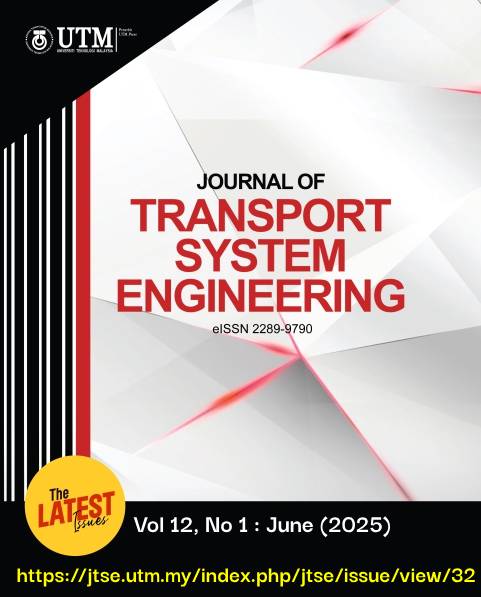Effect of Worn Top Compression Ring and Lubricant Degradation Towards Engine In-Cylinder Frictional Losses
DOI:
https://doi.org/10.11113/jtse.v12.244Keywords:
Piston ring lubrication, Film thickness, Friction, Power loss.Abstract
Friction occurs in the internal combustion engine especially at the interface between piston ring and cylinder liner. This causes an increase in fuel consumption required to overcome these frictional losses. Piston ring-cylinder interface is one of the primary sources. This study is imperative to understand the effects of lubrication degradation and worn top compression ring towards engine frictional losses. A mathematical model with the integration of 1-D Reynold’s equation is derived to investigate the lubrication film and pressure generation. This study further incorporates velocity, surface roughness, combustion pressure, lubrication degradation and presence of worn top compression ring to demonstrate the frictional losses. It was found that lubrication degradation significantly affects the lubrication film formation, impacting friction at the piston ring-cylinder liner interface. Increased lubricant viscosity increases viscous friction while reducing boundary friction. Similarly, a worn top compression ring leads to higher viscous friction due to a thicker film and larger load-bearing area, decreasing boundary friction. It is concluded that both lubrication degradation and worn top compression rings have detrimental effects on frictional power losses.
References
Menacer, B., & Bouchetara, M. (2020). The compression ring profile influence on hydrodynamic performance of the lubricant in diesel engine. Advances in Mechanical Engineering, 12(6), 168781402093084. https://doi.org/10.1177/168781402093084
Turnbull, R., Dolatabadi, N., Rahmani, R., & Rahnejat, H. (2020). An assessment of gas power leakage and frictional losses from the top compression ring of internal combustion engines. Tribology International, 142, 105991.
Rahmani, R., Theodossiades, S., Rahnejat, H., & Fitzsimons, B. (2012). Transient elastohydrodynamic lubrication of rough new or worn piston compression ring conjunction with an out-of-round cylinder bore. Proceedings of the Institution of Mechanical Engineers, Part J: Journal of Engineering Tribology, 226(4), 284–305.
Styles, G., Rahmani, R., Rahnejat, H., & Fitzsimons, B. (2014). In-cycle and life-time friction transience in piston ring–liner conjunction under mixed regime of lubrication. International Journal of Engine Research, 15(7), 862–876.
Jeng, Y.-R. (1992). Theoretical analysis of piston-ring lubrication Part I—Fully flooded lubrication. Tribology Transactions, 35(4), 696–706.
Morris, N. A., Rahmani, R., Rahnejat, H., King, P. J., & Howell-Smith, S. J. (2015). A numerical model to study the role of surface textures at top dead center reversal in the piston ring to cylinder liner contact. Journal of Tribology, 138(2).
Söderfjäll, M., Herbst, H. M., Larsson, R., & Almqvist, A. (2017). Influence on friction from piston ring design, cylinder liner roughness and lubricant properties. Tribology International, 116, 272–284.
Morris, N., Rahmani, R., Rahnejat, H., King, P., & Fitzsimons, B. (2012). The influence of piston ring geometry and topography on friction. Proceedings of the Institution of Mechanical Engineers, Part J: Journal of Engineering Tribology, 227(2), 141–153.
Sonthalia, A., & Kumar, C. (2013). The effect of compression ring profile on the friction force in an internal combustion engine. Tribology in Industry, 35(1), 74–83.
Jadhav, N. (2013). Friction losses between piston ring–liner assembly of internal combustion engine: A review. International Journal of Scientific and Research Publications, 3(6).
Balakrishnan, S., & Rahnejat, H. (2005). Isothermal transient analysis of piston skirt-to-cylinder wall contacts under combined axial, lateral and tilting motion. Journal of Physics D: Applied Physics, 38(5), 787–799.
Teodorescu, M., Taraza, D., & Henein, N. A. (2003). Simplified elasto-hydrodynamic friction model of the cam–tappet contact. JSTOR. https://www.jstor.org/stable/44741353
Downloads
Published
How to Cite
Issue
Section
License
Copyright of articles that appear in Journal of Transpot System Engineering (JTSE) belongs exclusively to Penerbit Universiti Teknologi Malaysia (Penerbit UTM Press). This copyright covers the rights to reproduce the article, including reprints, electronic reproductions or any other reproductions of similar nature.
Disclaimer: The views and opinions expressed in the articles are those of the authors and do not necessarily reflect the official policy or position of the JTSE. Examples of analysis performed within are only examples and they should not be utilized in real-world. Assumptions made within the analysis are not reflective of the position of any JTSE entities.


















